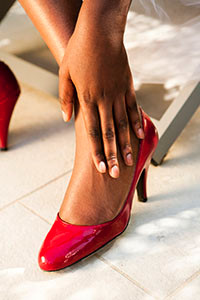Webster (281) 316-3338
Alvin (281) 331-3525
Webster (281) 316-3338
Alvin (281) 331-3525
 There are ligaments that surround the cuboid bone, and if an injury should occur that affects this part of the foot, a condition that is known as cuboid syndrome may develop. You may notice pain and discomfort on the side of your foot, and it can worsen as weight is put on it. Some patients can lose the ability to move the foot, and the toes may appear swollen and weak. The most common causes of this type of injury can include twisting your ankle during a fall, or participating in sporting activities which can cause ankle pain. Additionally, this ailment can develop from wearing shoes that do not fit correctly, being overweight, or not stretching the feet before exercising. Mild relief can be found when the affected foot is elevated, and it may be beneficial to wrap the ankle with an elastic bandage that provides support. If you have pain on the side of your foot, it is suggested that you speak to a podiatrist who can properly treat this condition.
There are ligaments that surround the cuboid bone, and if an injury should occur that affects this part of the foot, a condition that is known as cuboid syndrome may develop. You may notice pain and discomfort on the side of your foot, and it can worsen as weight is put on it. Some patients can lose the ability to move the foot, and the toes may appear swollen and weak. The most common causes of this type of injury can include twisting your ankle during a fall, or participating in sporting activities which can cause ankle pain. Additionally, this ailment can develop from wearing shoes that do not fit correctly, being overweight, or not stretching the feet before exercising. Mild relief can be found when the affected foot is elevated, and it may be beneficial to wrap the ankle with an elastic bandage that provides support. If you have pain on the side of your foot, it is suggested that you speak to a podiatrist who can properly treat this condition.
Cuboid syndrome, also known as cuboid subluxation, occurs when the joints and ligaments near the cuboid bone in the foot become torn. If you have cuboid syndrome, consult with Dr. Douglas Webb from Texas. Our doctor will assess your condition and provide you with quality foot and ankle treatment.
Cuboid syndrome is a common cause of lateral foot pain, which is pain on the outside of the foot. The condition may happen suddenly due to an ankle sprain, or it may develop slowly overtime from repetitive tension through the bone and surrounding structures.
Causes
The most common causes of cuboid syndrome include:
Symptoms
A common symptom of cuboid syndrome is pain along the outside of the foot which can be felt in the ankle and toes. This pain may create walking difficulties and may cause those with the condition to walk with a limp.
Diagnosis
Diagnosis of cuboid syndrome is often difficult, and it is often misdiagnosed. X-rays, MRIs and CT scans often fail to properly show the cuboid subluxation. Although there isn’t a specific test used to diagnose cuboid syndrome, your podiatrist will usually check if pain is felt while pressing firmly on the cuboid bone of your foot.
Treatment
Just as the range of causes varies widely, so do treatments. Some more common treatments are ice therapy, rest, exercise, taping, and orthotics.
If you have any questions, please feel free to contact one of our offices located in Alvin and Webster, TX . We offer the newest diagnostic and treatment technologies for all your foot care needs.